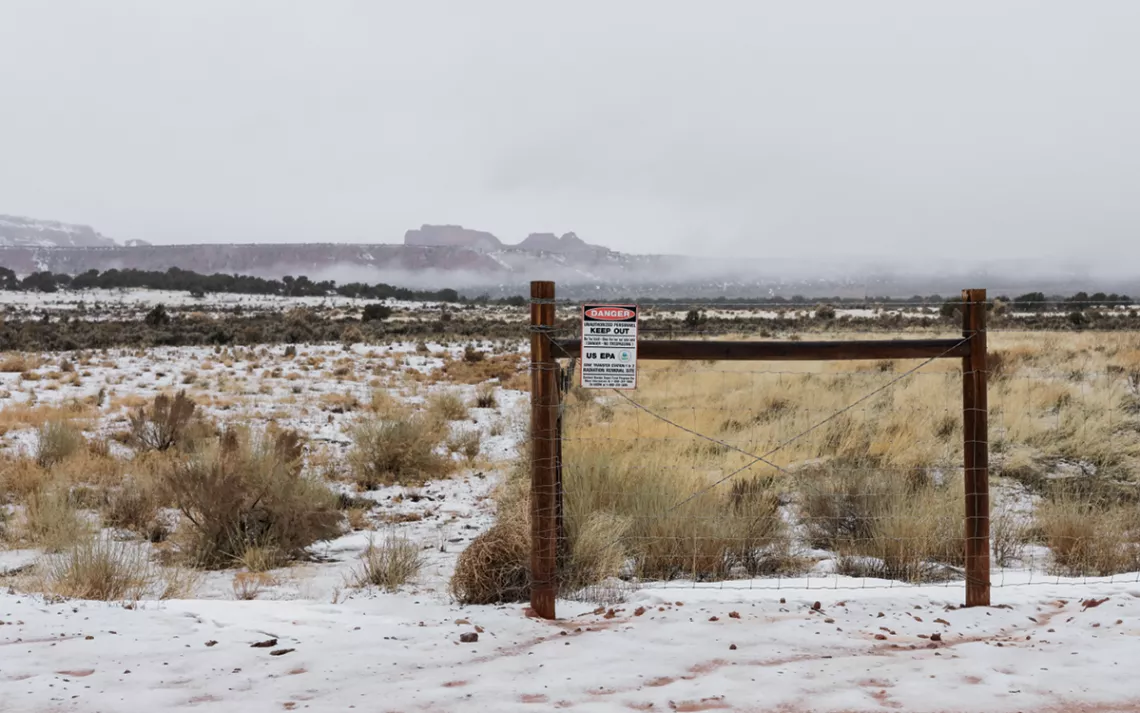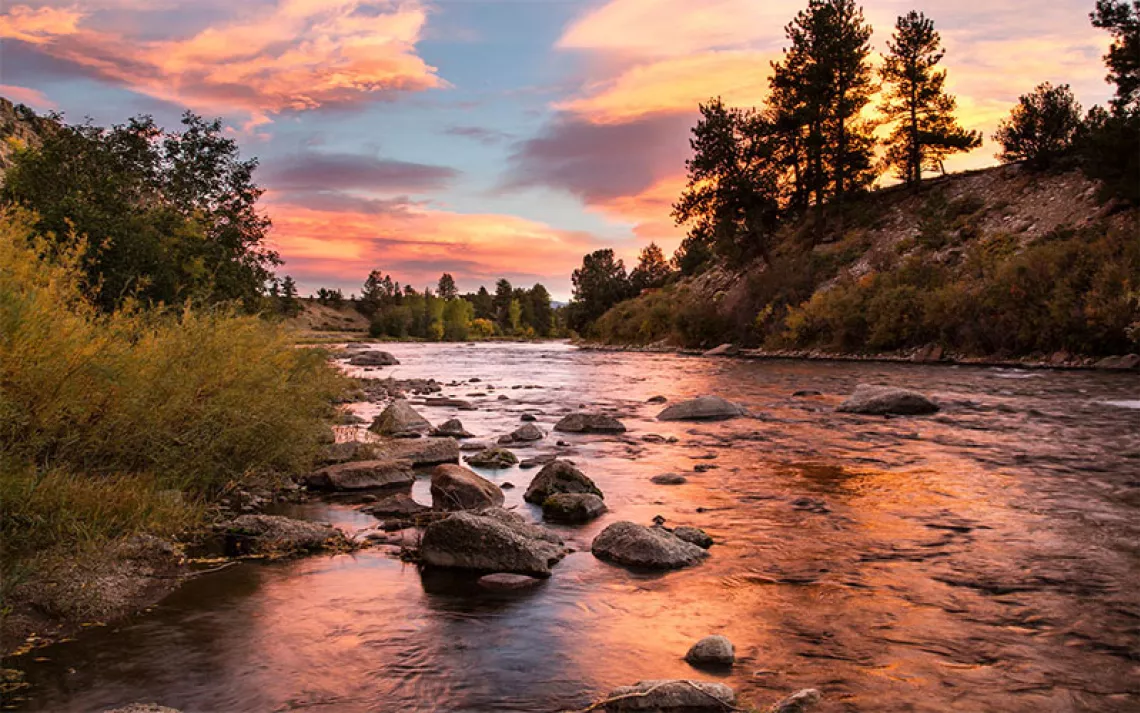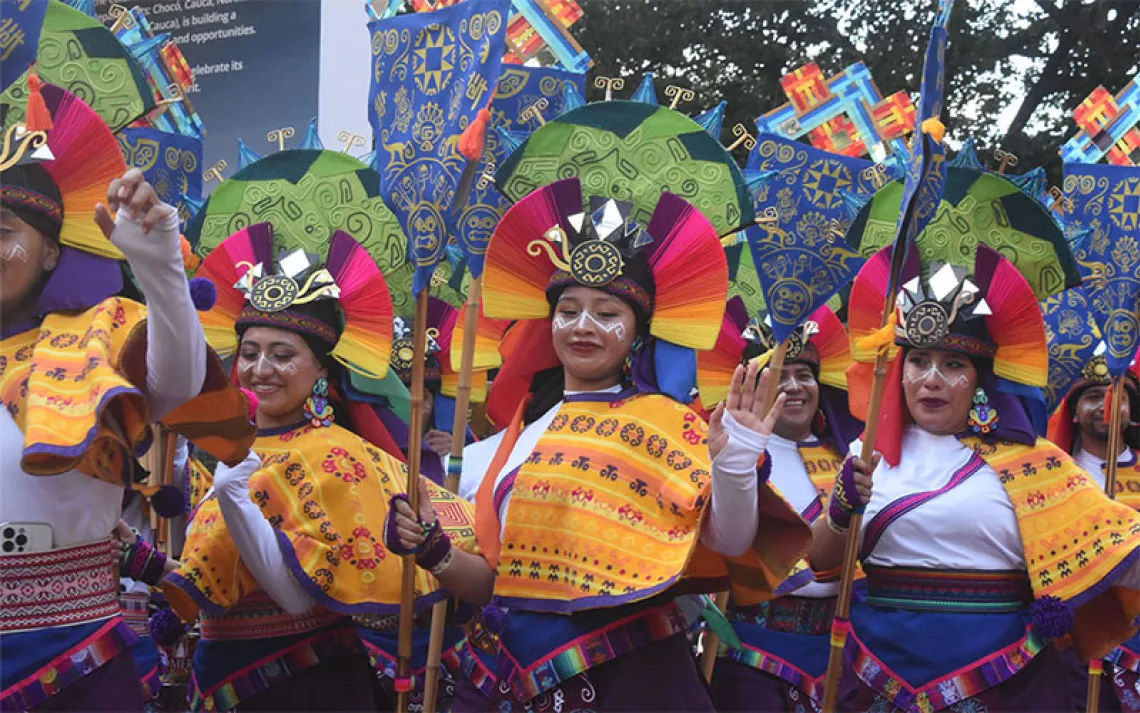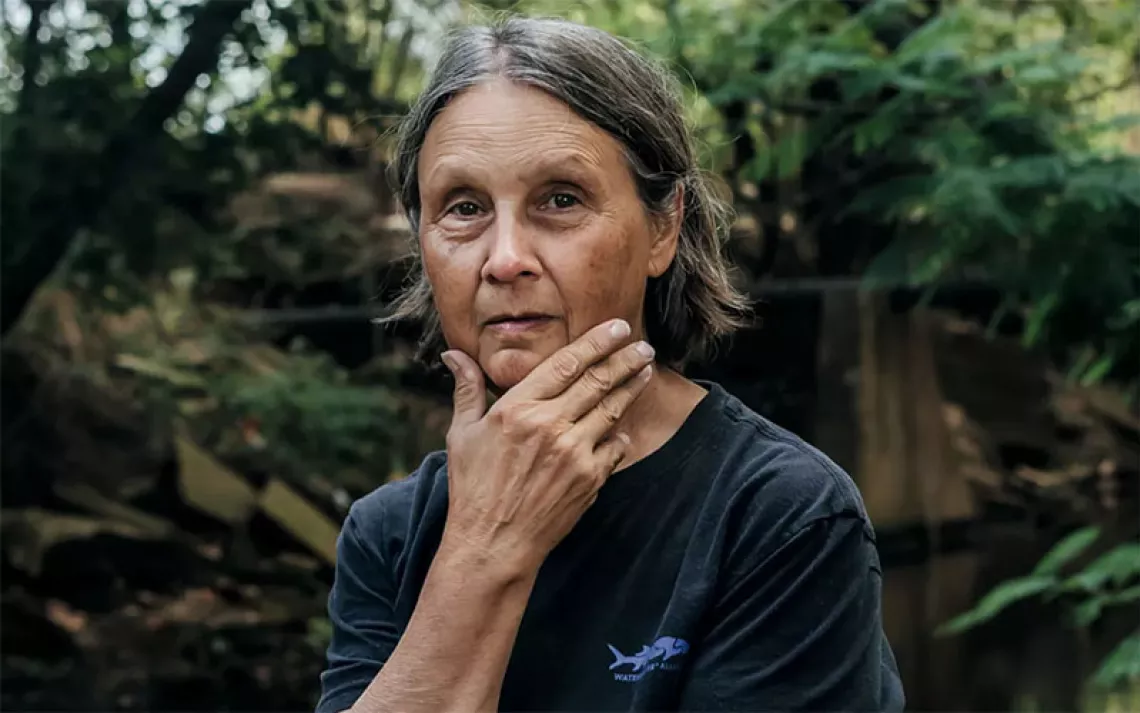Uranium Widows in Navajo Country
Uranium mining has been banned in Navajo country—could it come back?

A sign in Cove, Arizona, warning visitors about buried tailings from a uranium mine. | Photos By Jennifer Hubbell
IN WINTER, EVELYN YAZZIE is out of bed hours before first light. Usually, it's because she's cold even under her covers, since the wood-fired furnace in her home has gone out. Most mornings, she splits firewood and then walks to the sheep corral to fill the buckets with food and water. This is all done before her mother, Delores, is up and Evelyn needs to help her get ready for the day.
In this part of the Navajo Nation, it wasn't always common for women to take care of the house and livestock the way Evelyn does. She learned these chores in the late 1950s, when her father, Peter Yazzie Sr., began working in the newly established uranium mines in the nearby town of Cove, Arizona. "Dad taught me how to chop wood, how to take care of the house," she said." He taught me when I was as young as six or seven, because I was the oldest."

Jessie Harrison and her daughter, Verma. Verma's father died after working in the uranium mines.
Peter got along well with everyone. When he wasn't at the mines, he was out riding horses with Evelyn and the other kids or giving haircuts to men in Cove. His marriage to Delores was arranged by their families, and they loved each other deeply. But the family didn't get to spend much time together. In 1970, just as Evelyn was about to graduate from high school, Peter rapidly fell ill and died from lung disease. He was only 49.
At 5 A.M., Evelyn prepares breakfast—toast with eggs sunny-side up—while Delores, now 85, takes a shower. Around a quarter after six, a shuttle arrives in front of their house and takes Delores and a few others along miles of iced-over mud in Cove to Shiprock, New Mexico, about an hour away. Delores receives dialysis for her failing kidneys at a clinic there three times a week. Many residents of Cove have kidney problems—a legacy, the locals say, of the mines.
The uranium mines were abandoned more than half a century ago. Now, many locals worry that the US government might try to reopen them. If the Trump administration gets its way, their fears will be confirmed. In March, Secretary of State Mike Pompeo said that the COVID-19 pandemic proved that the United States needs to take mining for uranium into its own hands. In April, Secretary of Energy Dan Brouillette released a strategy to revive uranium mining across the country as a "matter of national security." In May, District of Arizona judge David Campbell ruled that a mining company named Energy Fuels could resume uranium-mining operations near the Grand Canyon. That same month, the Trump administration discussed carrying out the first nuclear tests since 1992. In July, EPA head Andrew Wheeler signed a memorandum of understanding with the Nuclear Regulatory Commission, agreeing to limit the EPA's authority to investigate tainted groundwater at uranium-mining sites. President Trump asked Congress for $1.5 billion to establish a new national uranium reserve.
The first time it set out to become a nuclear superpower, the United States failed to consider the people in the path of that quest and the environmental consequences. Decades later, the Navajo have little reason to believe this time will be different.
IN THE EARLY 20TH CENTURY, the Navajo in the area lived in a matriarchal society. Women owned property and livestock, and they passed that wealth on to their daughters. In the 1930s, the federal government declared that the Navajo were overgrazing their land. Federal agents rounded up the sheep, goats, horses, and cows on the reservation—sometimes selling them off, sometimes slaughtering them on the spot.

Phil Harrison Jr. Phil's father died after working in the uranium mines.
With most of the livestock gone, the Navajo were forced to look for work off the reservation. In less than a generation, Navajo women went from being economically self-sufficient to being dependent on men. Many Navajo men left to work on railroads in California and never returned.
In the 1940s, prospectors found uranium in Cove. At the time, the US Atomic Energy Commission was aggressively subsidizing uranium production, as the Trump administration is trying to do today. A company called Kerr-McGee struck a deal with the Navajo Tribal Council in 1952 to open a mine. The Navajo were excited to have steady work so close. "The employment came to us," Delores said.
As a child, Delores watched Cove change from a sleepy town to one crowded with trucks hauling people into the mines or transporting ore to be refined at Shiprock. "It was hustle and bustle. There were lots of people who didn't live here," Evelyn said. "They'd come in, set up camp, and stay here for work."
Peter would wake up early and walk to Kerr-McGee's main offices, about five miles away, and the company would drive him and other miners to the mountains. The miners worked with minimal protective equipment—at best, just a hard hat—and were never told about any potential dangers. They took their lunch breaks underground, and in the hot and dry summer months, they would drink the water that dripped inside the mines to quench their thirst. In the evenings, Peter would return home, clothes caked in mud and yellow uranium ore. Delores would wash his clothes, scrubbing them hard on the washboard to remove the mud before hanging them over the sagebrush to dry.

A dirt road curves through desert terrain in Cove, Arizona.
Uranium ore is radioactive; its status as a heavy metal means that it can disrupt the endocrine system, damage organs, and lead to cancer. Buried in the earth, it doesn't pose much of a problem, but mining operations in Cove brought the ore to the surface and crushed it as part of the refining process, creating dust that spread through the community via wind and water.
In the mid-1960s, nearly two decades after Kerr-McGee began operations in Cove, the Atomic Energy Commission announced that the government would be winding down the purchase of uranium—it had acquired far more than it could store easily. Without the subsidies, Kerr-McGee had to begin closing the mines. A few years later, Evelyn, who was attending boarding school in Brigham City, Utah, came home to visit and was shocked to see that her father had become ill while she was gone. "He was skin and bones. He had a hard time breathing. I didn't recognize him," she said.
By the 1950s, Kerr-McGee and the US government knew that uranium mining likely caused cancer and lung disease, but they did not share that information with the miners. The Navajo had their own suspicions. After the mines closed, a former miner living in Cove named James Smith started collecting the names of colleagues who had died. His initial list had over 40 names on it. Other community members began to do their own research, and as of 2018, there were 285 names on the list. The local radio station—with the families' permission—announced the names of the deceased miners on the air.
A SMALL GROUP OF NAVAJO WIDOWS began gathering at the Red Valley Chapter House. At first, Delores was hesitant to go. She thought grief was something to be dealt with in private. But one day she found herself accepting a ride to the chapter house from one of the other widows. There she met women who had seen their husbands fall ill as she had done. She kept going back.
The widows reasoned that because the government couldn't make their husbands healthy again or bring them back from the dead, it needed to pay, somehow, for what it had done. They contacted the Navajo Tribal Council delegate for the Red Rock Chapter, who helped the group reach out to then–interior secretary Stewart Udall. Udall met the widows in Shiprock and urged them to travel to Washington, DC, to tell their stories to members of Congress.
Delores remembers traveling to DC with a group of widows to testify in 1979. Local council delegates and the Navajo Nation helped pay for their travel. Others in the community helped fundraise through bake sales.
That trip was her first time flying. "It was scary," Delores said, recalling the turbulence as the aircraft passed through clouds. She wrote down her testimony in Navajo and watched as someone else read a translated version at the hearing. She remembers that the senators seemed moved by her and the other widows' stories.

Delores's testimony was part of a push for legislation to compensate uranium miners, test site workers, and people who had been downwind of nuclear tests (known as "downwinders"). It would be a decade before that effort began to yield results.
MEANWHILE, THE WIDOWS SUPPORTED themselves any way they could. Delores wove rugs, worked as a foster parent, and took odd jobs. She never remarried. "I had a good man," she said. "I don't think I'll find another good man, so I just stayed by myself and stayed with my children." Evelyn helped the family by working at restaurants and summer camps off the reservation.
Jessie Harrison, a uranium widow who testified in DC in 1980, never went to high school or college. She worked at a computer chip factory and as a flag waver at a construction site and a cashier at a trading post. "She forced herself to learn how to use machines and calculators," her oldest son, Phil, said. "She had to learn fast. She had to train herself to be strong."
After her husband died, Harrison was depressed and struggled to support her children, to the point where she had to send her five-year-old daughter off to a Bureau of Indian Affairs boarding school in order to keep on working. With her husband and so many of the men of his generation gone, Harrison had to take on the role of passing down the oral history, teachings, and cultural norms to her sons.
Phil was 20 when his father died. He drove trucks and worked as a heavy-equipment operator while taking care of his siblings and helping support the family. The many hats he has worn—now also as a father, a provider for his mother, and a consultant for both the Navajo Uranium Radiation Victims Committee and a home health care center—is a testament to how quickly he and other miners' children had to adapt.
It was 1990 before the survivors received any formal recognition for what they had gone through. That year, Congress passed the Radiation Exposure Compensation Act, which provided a one-time settlement for affected people or their surviving family. After assembling the pay stubs, health records, and other documents to file her claim, Delores received $100,000. Split between Peter Yazzie's family members, the money disappeared almost instantly.
In 2012—nearly 50 years after Kerr-McGee left—the EPA began cleaning up the mine waste in Cove. The mine tailings that had been heaped in massive dunes outside Cove Day School since the 1960s were trucked away and buried in a nearby field. The field was fenced in with barbed wire, and a sign was placed outside warning passersby of radioactive material.

James Smith with a hard hat from his uranium-mining days.
Two years later, the Department of Justice settled a lawsuit filed against Kerr-McGee. In the largest environmental-cleanup settlement to date, Anadarko Petroleum Corporation—which had acquired Kerr-McGee in 2006—would pay out $5.15 billion. About one-fifth of those funds are designated for cleaning up approximately 50 abandoned uranium mines in the Navajo Nation, including the 32 that Kerr-McGee abandoned in the Cove area. (There are more than 1,000 abandoned uranium mines throughout the Navajo Nation.) But there are no definitive federal or regional cleanup plans yet for any of the mines covered in the settlement—the ones dug by Kerr-McGee or the ones created by lesser-known companies that went bankrupt long before anyone could sue them for the damage they left behind.
All told, cleaning up a single abandoned uranium mine would be incredibly costly, said Kathy Setian, a retired EPA project manager who worked in environmental remediation. The contaminants in uranium and other heavy metal mine waste persist forever, said Chris Shuey, a uranium-mine expert at the Southwest Research and Information Center, a nonprofit in Albuquerque that focuses on nuclear issues. Because of this, mine waste is usually backfilled into the mine it was dug out of, or it's interred at a newly constructed off-site disposal facility. In either case, it must be sequestered in a way that will "minimize wind and water erosion, literally forever," Shuey said. Treatment plants must also be built to remove arsenic and uranium from drinking water.
UNTIL THE CLEANUP IS FINISHED, uranium and other heavy metals from the mines will continue to affect the land, the water, and the health of the people who live around them, said Johnnye Lewis, a non-Native researcher at the University of New Mexico in Albuquerque who has worked with the Navajo for over two decades.
Lewis and her colleagues have found that uranium levels are higher in Navajo communities than in others across the United States and that Navajo who live near mines or areas where mine tailings were stored have a higher likelihood of developing hypertension and autoimmune diseases.
And the impacts of uranium are moving from one generation to the next. In the past, scientists believed that uranium would not cross the placental barrier, Lewis said. Over the past decade, Lewis has been involved in the Navajo Birth Cohort Study, which examines the levels of uranium in mothers and their children. When she and her colleagues tested the first urine samples of newborns in the Navajo Nation, they found high uranium levels.
They don't know why the levels have stayed so high, since uranium has not been mined for decades. "We can't identify the direct source of these exposures," Lewis said. Waste from the uranium mines was often left on the ground in unmarked locations. It can be picked up and carried by the wind, and food grown on soil contaminated by it can spread it farther. New and unpublished research by Lewis and her colleagues suggests that it's possible that nanoparticles of uranium are becoming aerosolized so that they're able to travel deep into the lungs when inhaled.
Lewis hopes that her research can inform policy around how the toxic waste is dealt with—or better yet, hasten the cleanup of the mines. "If this data can make people aware that these issues are out there and get considered in decisions politically, that's the most we can hope for," she said. "It's one thing to make mistakes when you don't have data. It's another thing when you know that something is harmful."
WHEN THE CLEANUP FIRST BEGAN, community members regularly showed up at meetings led by the EPA. But in recent years, attendance has dwindled, according to Robertson Tsosie, whose father died from lung cancer after working in the mines. "I think lots of community members have lost trust with them," he said.
"EPA's been here for over five years," said Tsosie's mother, Minnie. "All they're doing is testing, testing. I don't know what they're testing for. When is the actual cleanup going to start? How are they going to clean it up?" Many Cove residents are convinced that the stalling is deliberate and that the EPA is in on a plot to reopen the mines.
Uranium mining and processing has been banned on Navajo Nation land for the past 15 years, but it's not clear if that ban would be respected under a federal mandate to revive uranium mining on national security grounds. Navajo laws haven't been respected in the past. The US-Navajo Treaty of 1868 guaranteed sovereignty to the Navajo Nation, but in 1919, Native reservation lands were opened to leasing by the Interior Department anyway.
Evelyn Yazzie fears that despite everything that the uranium widows and their children have done, they won't be able to protect future generations from what will happen if the mines reopen.
Her mother tries to think otherwise. "I hope," Delores said, "someone will be strong enough to say no."
This article appeared in the November/December 2020 edition with the headline "The Legacy."
This article was funded by the Sierra Club Foundation and the Society of Environmental Journalists’ Fund for Environmental Journalism.
 The Magazine of The Sierra Club
The Magazine of The Sierra Club



